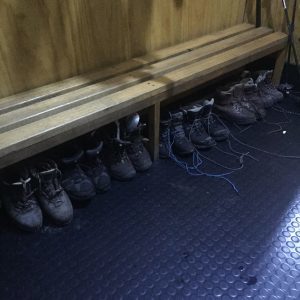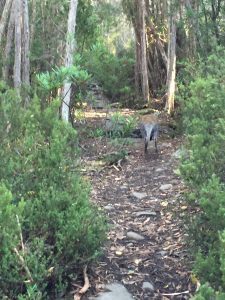Six Things I Learned Hiking the Overland Track in Tasmania
 My husband and I just returned from a dream vacation to celebrate our upcoming 25th anniversary: a hiking trip along the Overland Track in Tasmania, the island-state off Australia’s southeastern coast. The trip we booked through the Tasmanian Walking Company was a guided trek, 50 miles over the course of six days, through the Cradle Mountain/Lake St. Clair National Park.
My husband and I just returned from a dream vacation to celebrate our upcoming 25th anniversary: a hiking trip along the Overland Track in Tasmania, the island-state off Australia’s southeastern coast. The trip we booked through the Tasmanian Walking Company was a guided trek, 50 miles over the course of six days, through the Cradle Mountain/Lake St. Clair National Park.
Together with four other hikers and two guides, we hiked long days over terrain that varied from wooden boardwalk (to save vegetation and keep us from sinking into bogs) to mud puddles to gravel to rough rock, downhill to see waterfalls and lakes and back up again to the ravishing views from glacial peaks, all while carrying backpacks weighing 25-30 lbs. The physical challenge induced the kind of mental focus that leads to revelations, of which I experienced at least six:
There’s preparation, and there’s preparation. Reading over the copious literature sent by the guide company ahead of time, one thing was clear: this walk was not for the unprepared. There were at least three paragraphs in every brochure and email about making sure our hiking boots were sturdy, broken in, and waterproof, all of which we took to heart. In the months before we left I regularly walked eight or nine miles at a clip, and my husband figures he had at least fifty miles on his newish boots before we boarded our plane.
Hahhahhhahahaha. Next time, we’ll make like the Proclaimers and walk five hundred miles, while we carry bags of rocks.
Seriously, there’s walking in your new boots, and then there’s hiking the Overland Track in them. I had a few hotspots – those tingling precursors to blisters – before lunchtime on Day 1. Luckily I also have ballerinas for daughters, so I knew that when it comes to feet, to wince is human but to tape is divine. Our preternaturally prepared guides slapped some medical tape on my heels on Monday, and by the time I pulled it off fifty miles later on Saturday afternoon, it was grimy and gray and my feet were making audible noises of protest…but there were no blisters.
 2. Leeches are ticklish. Here’s what freaked me out the most about the leeches we encountered on Day 4 as we hiked through the Tasmanian rainforest: they didn’t really freak me out. It helped that the guides, Tom and Gemma, had by that time thoroughly inculcated us in the beauty and intelligent design of the Tasmanian bush – the fagus leaf looks like a crinkle-cut chip to collect water, those cushionplants are an example of convergent evolution, the Jack Jumper ants put white stones on top of their nests to repel the sun during hot spells, and black stones when it’s cold to retain heat. It was all fascinating, so why would leeches be any different?
2. Leeches are ticklish. Here’s what freaked me out the most about the leeches we encountered on Day 4 as we hiked through the Tasmanian rainforest: they didn’t really freak me out. It helped that the guides, Tom and Gemma, had by that time thoroughly inculcated us in the beauty and intelligent design of the Tasmanian bush – the fagus leaf looks like a crinkle-cut chip to collect water, those cushionplants are an example of convergent evolution, the Jack Jumper ants put white stones on top of their nests to repel the sun during hot spells, and black stones when it’s cold to retain heat. It was all fascinating, so why would leeches be any different?
It also helped that by Day 4 our small group of hikers was also experiencing convergent evolution, whether it was pulling water bottles out of each other’s packs, sharing around a tube of sunscreen (the human equivalent of white stones on the nest,) or saying “Ria! You have another one! Below your left knee! It’s big!” We were Team #AllLeechesLeftBehind.
But mostly it helped that guide Gemma taught us the “tickle and flick” move – when you find a leech, you tickle its back until it releases its grip, then you flick it back into the bush. When I undid my gaiters back at the hut at the end of the rainforest day to find one on my right calf, I just suppressed a scream and did Lamaze breathing, confident that Ria would tickle and flick it away.
 3. Australia wants to kill you, especially if you’re American. Each night we repaired to snug little eco-friendly huts just off the track, where Tom and Gemma prepared three course dinners while we enjoyed the comfort of 5 minute hot showers and Tasmanian wines. As the only Americans on the trip, most of the dinners were spent having our new Aussie friends describe all the things that could kill us in their fair country, from the aforementioned Jack Jumper ants (anaphylaxis) to redback spiders (“they lurk under toilet seats!”) to tiger snakes (“the key to surviving their bite is to stay relaxed,” said guide Tom, who was so damn competent that he probably would stay relaxed.)
3. Australia wants to kill you, especially if you’re American. Each night we repaired to snug little eco-friendly huts just off the track, where Tom and Gemma prepared three course dinners while we enjoyed the comfort of 5 minute hot showers and Tasmanian wines. As the only Americans on the trip, most of the dinners were spent having our new Aussie friends describe all the things that could kill us in their fair country, from the aforementioned Jack Jumper ants (anaphylaxis) to redback spiders (“they lurk under toilet seats!”) to tiger snakes (“the key to surviving their bite is to stay relaxed,” said guide Tom, who was so damn competent that he probably would stay relaxed.)
By the time we reached a lake where a brown trout swam lazily under our feet on the dock, and our fellow hikers said, “That’s no trout, it’s the famous Anti-American Fish that will jump out and bite your jugular, he’s just waiting for you to look away,” we didn’t even question it, just put our hands on our necks.
Aussies and Americans speak two different languages. The other dinner topic was What The Hell Did You Just Say? First there’s the fact that Aussie truncate everything. Hot chocolate becomes “hot chokkie” becomes just “chokkie”, mosquitoes are “mozzies,” and my favorite – spaghetti Bolognese becomes “spag boll.” How tired are your vocal chords, Australia, that you can’t finish a word?
Also, a lot of their idioms presume an intimacy with reptiles which I as an American mercifully lack. “You know, flat out like a lizard drinking!” or “Mad as a cut snake!” For my part I taught them “Hella” and “Cash me ousside, how ‘bout dah” so you’re welcome, Oz.
She who laughs, sees no wombats. We had some trepidation before the trip about the strangers with whom we’d be spending our six days in very close quarters – if they were weird or mean, there would be no escape. Instead we had the opposite problem: our fellow hikers were so interesting and nice that we had a hard time shutting up while we walked. It didn’t seem to bother the wallabies much – we saw plenty, including this guy making his escape down the path.
 But where were the wombats, the Tasmanian devils, the platypodes (thank Tom and Gemma for teaching me the plural for platypus, at least in Australian, until they inevitably make it platties)? Probably hiding somewhere in the buttongrass as we marched past in a line, laughing hysterically about Melissa’s plans to someday meet Russell Crowe and ask him to tickle and flick her leeches (that she would draw on strategically with Sharpies.)
But where were the wombats, the Tasmanian devils, the platypodes (thank Tom and Gemma for teaching me the plural for platypus, at least in Australian, until they inevitably make it platties)? Probably hiding somewhere in the buttongrass as we marched past in a line, laughing hysterically about Melissa’s plans to someday meet Russell Crowe and ask him to tickle and flick her leeches (that she would draw on strategically with Sharpies.)
This too shall pass. On the last day, as we descended from Kia Ora hut down toward Lake St. Clair, letting gravity and the medical condition called “End-in-sight-us” pull us forward, Gemma asked me what I’d take away from my time in the wilds of Tasmania. I told her that simply being off the grid and away from American political news for a full six days was the gift, the ability to wake up and not have my stomach already clenched at #45’s latest pronouncement.
Gemma said that for her, she’s comforted by the site of the mountains that have been there for millions of years, because they remind her how inconsequential she is, how all of us are tiny specks on the timeline.
And I found that a helpful thing to remember. This, too, shall pass – you, me, and especially Trump. I’ve been home a couple days and he’s still at it (has anyone thought of dispatching him to Australia to see how he does with the indigenous species? Just a thought.)
Of course we have to continue to resist and fight – and as soon as I kick this jet lag, I’m ready to tap back in. But we also have to take a deep healing breath once in a while and remember that eventually, even his time will fade.
I bet Cathedral Mountain will still look just the same when it does.
 Why yes I did pack my tiny portable Bluetooth speaker and instigate a Neil Finn listening party one night, figuring it was location-appropriate. This is the song that everyone sang along with, wherever they were in the hut.
Why yes I did pack my tiny portable Bluetooth speaker and instigate a Neil Finn listening party one night, figuring it was location-appropriate. This is the song that everyone sang along with, wherever they were in the hut.











CommentsWe were but now we're back…fastest 12 days ever. Hopefully ... by Nancy Davis KhoThanks, Marianne, you and me both. I wish I could go back to ... by Nancy Davis KhoI was wondering when you'd update everyone. I'm so jealous of ... by LanceFascinating but I want a lot more! by Marianne LonsdaleRelated StoriesHat TrickRemember When I Was a Humor Blogger?Conflation Nation



